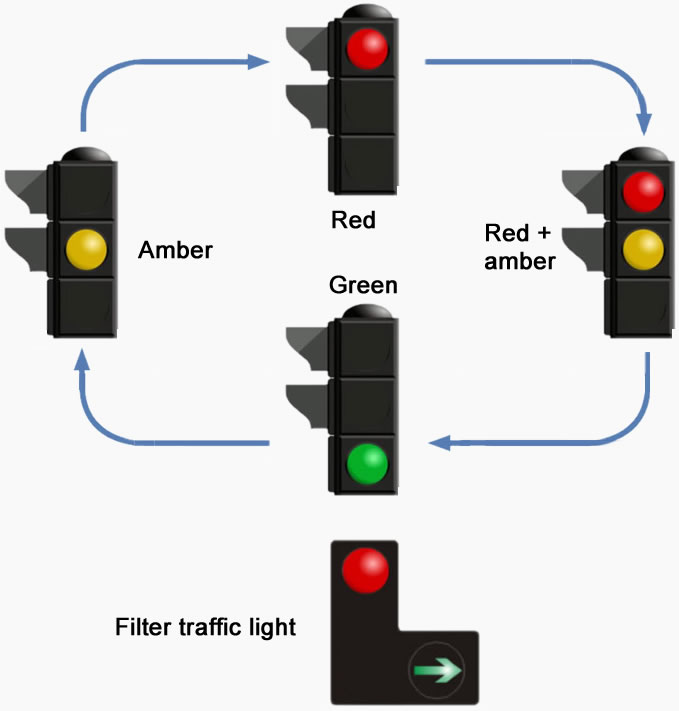How Modern Traffic Lights Signals Work?
 Traffic lights deliver efficient traffic flow, reduce travel time, minimise fuel costs, reduce rear-end collisions and minimise vehicle emissions.
Traffic lights deliver efficient traffic flow, reduce travel time, minimise fuel costs, reduce rear-end collisions and minimise vehicle emissions.
Even though they accomplish what is perceivably a complex, tedious and odd assignment on the roads without much fuss and are often thought to work in a complex and mysterious manner, traffic light signals work in a relatively simple way.
Core Elements of Traffic Lights Signal Systems
The basic elements of a traffic signal system are a controller, traffic light heads and detector. Acting as the “brains” behind the functioning of the lights system, a controller contains the necessary information for directing the lights through various sequences depending on the time of the day and location of the system. The detectors are used to spot the arrival of cars at intersections, entry of cars in turn lanes (so that arrow lights are activated) or stacking up of too many cars at intersections; while the light heads give the signals to vehicle and pedestrian crossing cycles.
Types of Traffic Light Signal Operations
a. Fixed Period
There are two major kinds of traffic light signal operations: fixed period and vehicle triggered.
Fixed-period traffic signals change according to pre-set timings (intervals) and have signal cycles all the time even when there are no pedestrian or vehicle demands. Pre-timed traffic lights work well on roads with predictable traffic patterns and slow speeds.
b. Vehicle Triggered
At road intersections with varying traffic patterns and higher speeds, traffic lights that can detect the presence of vehicles are necessary. In fact, traffic lights at intersections should not only detect trucks, automobiles and buses, but must also recognize bicycles, motorcycles and pedestrians.
Therefore, “triggered” traffic signals are used at such intersections because they are typically capable of maintaining green signals on the busiest streets until pedestrians or vehicles on the less travelled sides of the streets approach the intersections.
The Traffic Signs Regulations and General Directions 2002
There are two types of triggered traffic signals:
(i) Semi-triggered:
These installations only change their signals when there are vehicles or pedestrians on the side streets. Their side street green times vary with the traffic and there is a maximum and minimum value programmed.
(ii) Fully-triggered
These installations have signals that are programmed to change with maximum and minimum green times depending on pedestrian and traffic demands on all approaches. In fact, the signals change based on demands from every approach.
How The Signals Work
(a) Fixed Period
Fixed period traffic lights signals display green to each approach for the same time during each cycle regardless of traffic conditions.
Therefore, traffic light suppliers of these installations have found that they are adequate in massively congested areas but are quite wasteful when lightly-trafficked side roads are included within the same sequence as some cycles (that could be better used by busier approaches) will go without vehicles crossing.
(b) Vehicle Triggered (VT)
Actuated signals take into account the demands on all approaches and adjust their green times accordingly.
Relying on high-precision detectors installed above the signal heads or in carriageways to register traffic demands, vehicle triggered traffic lights process the registered demands in their controllers and then allocate green time in appropriate manner. The controller has specific minimum and maximum green times which cannot be violated.
When a vehicle passes the detector, it will demand a certain phase and induce the controller to turn on the green time. Once green time is on, it will continue as long as vehicles pass the detector. The green phase will only stop when traffic ceases on the approach and another approach gains green, or when a conflicting demand compels the maximum green timer to count down.
When triggered traffic lights signals are located at junctions with some lightly-trafficked side roads, the lights can be programmed to run only when there are traffic demands for them. Such traffic signs are classified as demand dependent and are perfect for pedestrian crossing facilities located within junctions.
The demand dependent traffic signalling systems at pedestrian crossing areas will only stop traffic when pedestrians are waiting to cross. Indeed, to make them more responsive to pedestrian needs, the installations are usually supplied with push buttons (placed on poles at intersection corners) that pedestrians can use to change the signals.
